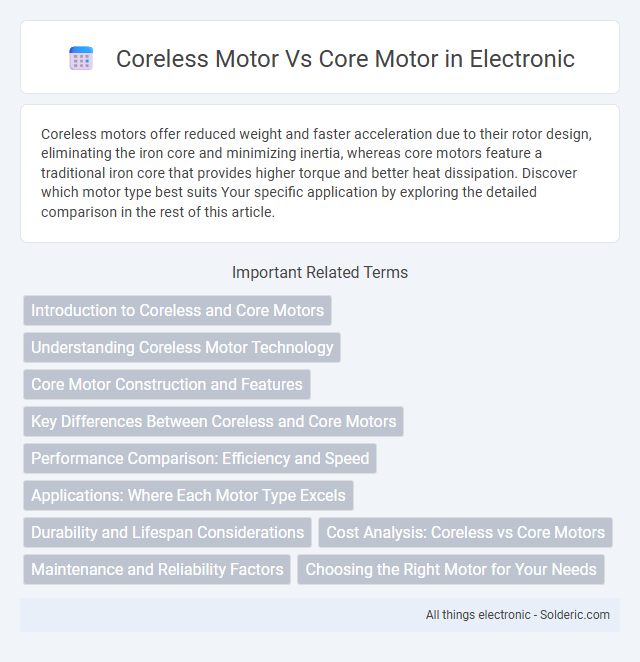Coreless motors offer reduced weight and faster acceleration due to their rotor design, eliminating the iron core and minimizing inertia, whereas core motors feature a traditional iron core that provides higher torque and better heat dissipation. Discover which motor type best suits Your specific application by exploring the detailed comparison in the rest of this article.
Comparison Table
| Feature | Coreless Motor | Core Motor |
|---|---|---|
| Construction | Rotor without iron core, uses self-supporting coils | Rotor with iron core, coils wound around iron laminations |
| Weight | Lighter due to absence of iron core | Heavier due to iron core |
| Efficiency | Higher efficiency with low inertia and reduced losses | Moderate efficiency, more core losses |
| Torque | Lower torque, but high torque-to-weight ratio | Higher torque output |
| Speed | Higher max speed due to low rotor inertia | Lower max speed |
| Heat Dissipation | Better heat dissipation as coils are exposed | Poorer heat dissipation, heat trapped in iron core |
| Applications | Precision instruments, drones, robotics, medical devices | Industrial machinery, automotive, general-purpose motors |
| Cost | Generally more expensive due to complex manufacturing | Less expensive, simpler manufacturing |
Introduction to Coreless and Core Motors
Coreless motors feature a rotor without an iron core, reducing weight and inertia for faster acceleration and higher efficiency, making them ideal for precision applications like robotics and medical devices. Core motors, also known as iron-core motors, use a laminated iron rotor core that provides higher torque and durability, commonly used in industrial machinery and automotive systems. The fundamental difference lies in the rotor construction, impacting performance characteristics such as response time, torque output, and energy consumption.
Understanding Coreless Motor Technology
Coreless motor technology eliminates the iron core from the rotor, resulting in significantly reduced weight and inertia compared to traditional core motors, which use an iron core. This design improves acceleration, responsiveness, and energy efficiency, making coreless motors ideal for precision applications like robotics and medical devices. The absence of cogging torque in coreless motors provides smoother operation and higher accuracy, distinguishing them from the core motor's typical torque ripple.
Core Motor Construction and Features
Coreless motors feature a rotor made of a self-supporting coil without an iron core, resulting in reduced rotor inertia and enhanced responsiveness. In contrast, core motors utilize an iron core in the rotor, which increases magnetic flux density but also adds weight and rotational inertia. The absence of core in coreless motors minimizes cogging torque, allowing smoother operation and higher efficiency in precision applications.
Key Differences Between Coreless and Core Motors
Coreless motors feature a rotor without an iron core, resulting in lower inertia and faster acceleration compared to core motors, which have a solid iron core that increases weight and magnetic losses. You will find coreless motors excel in applications requiring high efficiency, smooth operation, and rapid response, while core motors are preferred for their robustness and cost-effectiveness. Key differences include core construction, weight, efficiency, thermal performance, and torque characteristics tailored to specific use cases.
Performance Comparison: Efficiency and Speed
Coreless motors exhibit higher efficiency due to their reduced rotor inertia and absence of iron core losses, resulting in faster acceleration and more precise speed control compared to core motors. Core motors, containing iron cores, typically generate more electromagnetic drag, which slightly lowers overall efficiency and limits maximum speed. The lightweight design of coreless motors enables superior dynamic response and energy savings, making them ideal for applications requiring rapid speed variations and high precision.
Applications: Where Each Motor Type Excels
Coreless motors excel in applications demanding high precision and rapid acceleration, such as in medical devices, robotics, and aerospace instrumentation due to their low inertia and minimal cogging torque. Core motors are preferred in industrial machinery, automotive systems, and heavy-duty equipment where high torque and robustness are crucial for sustained operation. Coreless motors suit small, lightweight devices requiring smooth and quiet operation, while core motors dominate applications with larger power requirements and greater mechanical stress.
Durability and Lifespan Considerations
Coreless motors exhibit enhanced durability due to the absence of iron core, which reduces heat generation and mechanical wear, leading to longer operational lifespan in high-speed applications. Core motors, while generally robust, tend to experience increased friction and heat buildup caused by the iron core, potentially lowering their lifespan under continuous heavy use. Selecting a coreless motor is advantageous in applications demanding high efficiency and extended durability, whereas core motors remain suitable for environments where cost-effectiveness and moderate usage prevail.
Cost Analysis: Coreless vs Core Motors
Coreless motors generally have higher manufacturing costs due to their intricate winding process and the use of lightweight materials, leading to increased production expenses compared to core motors. Core motors, featuring a traditional iron core and simpler construction, offer a more cost-effective solution for high-volume applications without sacrificing durability. Despite the higher initial investment, coreless motors provide efficiency and performance benefits that may justify their premium cost in precision and high-speed applications.
Maintenance and Reliability Factors
Coreless motors require less maintenance than core motors due to the absence of iron cores, which eliminates issues like cogging and reduces wear from magnetic friction. Your equipment benefits from increased reliability with coreless motors, as they generate less heat and experience lower mechanical stress, extending motor lifespan. Core motors may demand more frequent maintenance due to iron core saturation and mechanical wear, impacting overall reliability over time.
Choosing the Right Motor for Your Needs
Coreless motors offer high efficiency, low inertia, and rapid acceleration, making them ideal for precision applications like robotics and aerospace. Core motors, featuring iron cores, provide greater torque and durability, suited for heavy-duty industrial machinery and automotive uses. Selecting between these motor types depends on balancing performance requirements, such as speed and torque, with application-specific constraints and cost considerations.
coreless motor vs core motor Infographic

 solderic.com
solderic.com